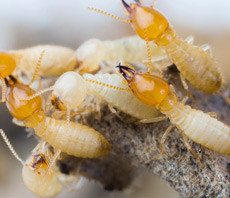 While we’re all familiar with the termite’s need for food, there are a number of other things termites are drawn to in Midwestern homes. Understanding what termites are attracted to, helps us understand where to look for signs of infestation. A better understanding also equips us with the right steps to take to prevent a termite-friendly environment.
While we’re all familiar with the termite’s need for food, there are a number of other things termites are drawn to in Midwestern homes. Understanding what termites are attracted to, helps us understand where to look for signs of infestation. A better understanding also equips us with the right steps to take to prevent a termite-friendly environment.
Moisture
Termites require a moist environment to survive and thrive. The eastern subterranean termite, Wisconsin’s most common termite, is especially attracted to moisture. Not only does moisture keep the termite’s body from drying out, but it also plays a role in two key functions: food and shelter. Digesting wood and other cellulose is incredibly difficult to do if it’s not somewhat wet.
Using a damp environment for building nests provides great shelter and traps moisture inside to sustain a colony.
Get A Free Quote
Inquiries
(800) 236-8735
Knowing the role moisture plays for termites makes it obvious that controlling moisture in your home is incredibly important in preventing an infestation. Areas such as crawl spaces and basements are common starting points for infestations. It’s important that your pipes and plumbing are in great working order, it’s also important to check for any leaks around the foundation, storm windows, or other areas where moisture may collect. Ventilation is also important in areas like bathrooms, basements and kitchens. Exhaust fans and dehumidifiers are great for preventing unnecessary moisture from collecting.
Darkness
Termites are naturally attracted to darkness, as it serves as protection against predators. Since almost all termites are blind, they have grown to thrive in the darkness and it plays a big part in their choice of living space. While keeping every nook and cranny of your home well-lit may not be a reasonable option, it’s important to keep in mind as it is not likely to find termites in well-lit areas.
Warmth
Termites can’t survive in cold temperatures, but that doesn’t mean they leave for the winter. While they may not be on the move and new infestations may not begin, termites are still active throughout the year. A cold house doesn’t necessarily mean that termites will be non-existent, and turning up the A/C won’t protect your home from an infestation. Understanding a termite’s need for warmth will help you pinpoint areas to look for signs infestation. In fact, termite inspectors sometimes look for hot spots in walls where termite colonies produce enough heat to show up on an infrared camera.
Cellulose and Other Food
While wood is a very popular meal for termites, cellulose is what they’re really after. Cellulose can be found in many forms other than wood, including paper, books, clothing, bird seed, cardboard and a ton of other things. It’s important to look for signs of infestation anywhere this material may be present.
With a little understanding of what termites need and what they’re attracted to, you’re more prepared to identify and prevent infestations. If you suspect you may have a problem, Terminix Wil-Kil’s termite control specialists are well-trained experts that can help identify termite issues and provide the proper extermination services, should an issue be found.
Contact Terminix Wil-Kil Pest Control for more information today.
What Do Termites Love in Sun Prairie, WI?
Terminix Wil-Kil Pest Control is a local Pest Control and Extermination company helping homeowners and businesses with pest issues across WI.
